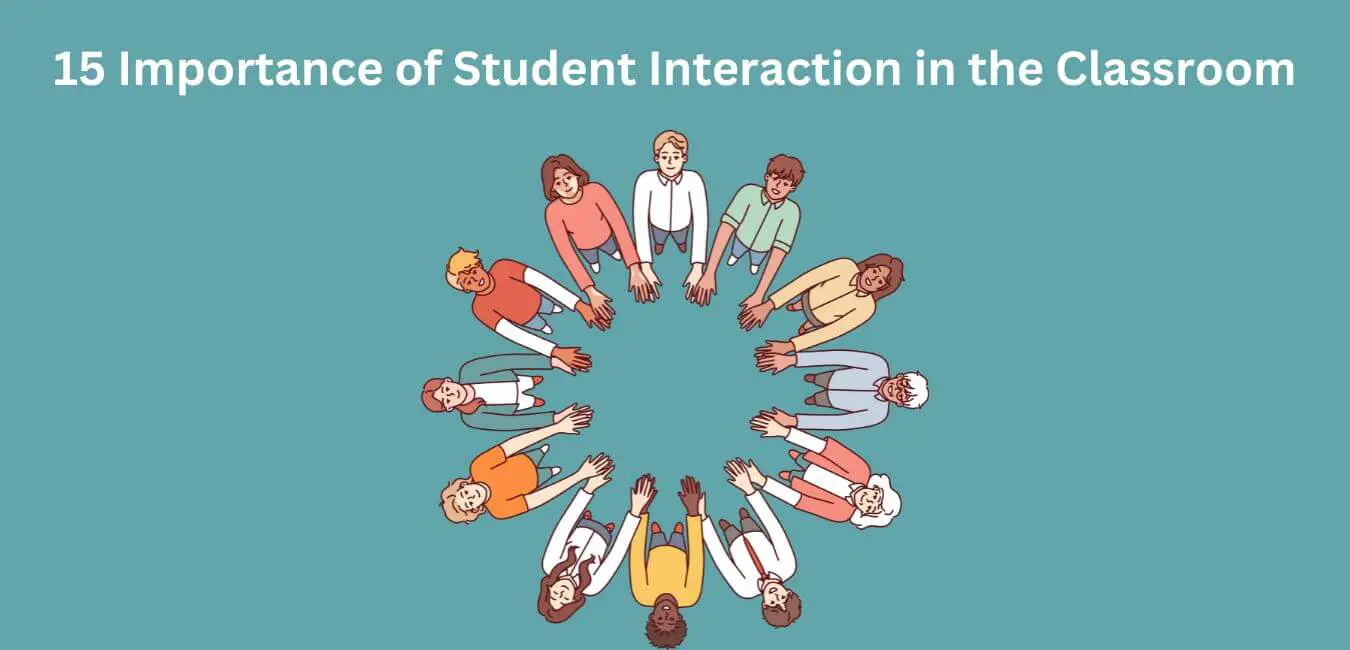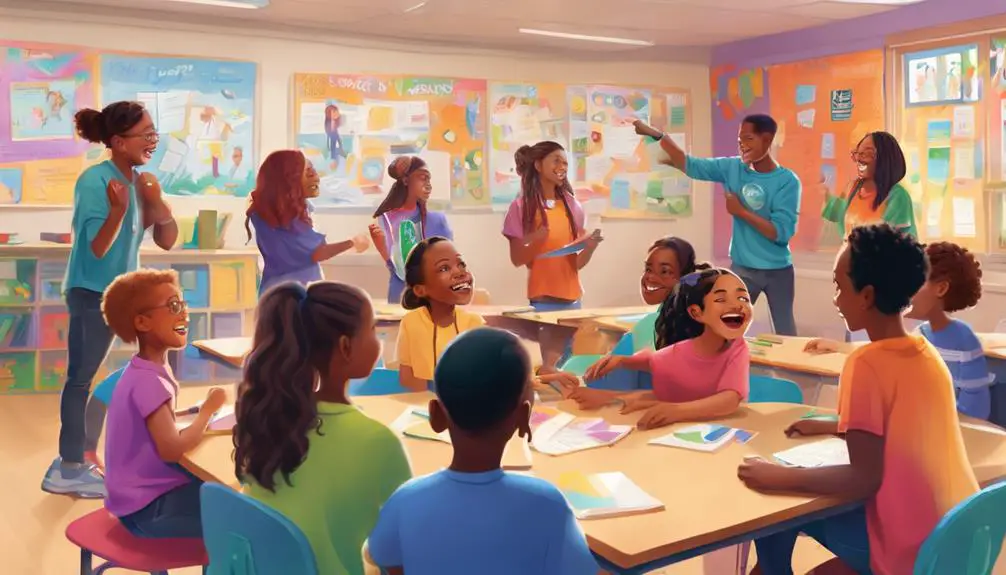In today’s educational landscape, student interaction in the classroom has gained significant recognition as a crucial component of effective learning. Gone are the days when education solely relied on teacher-centered instruction, where students passively absorbed information without actively engaging in the learning process. Instead, educators now emphasize the importance of fostering an environment that encourages student interaction and collaboration.
Student interaction refers to various forms of communication and engagement among learners within a classroom setting. It involves meaningful discussions, group activities, debates, peer-to-peer interactions, and more. This article explores 15 key reasons why student interaction is essential for creating an enriching educational experience.
Why is Student Interaction Necessary in the Classroom?
1. Increased engagement and motivation
One significant aspect of education is the importance of student interaction in the classroom. This allows for an environment where learners thrive and develop essential life skills. Increased engagement and motivation are just some of the benefits that arise from such interactions.
When students actively participate in classroom activities, they are more likely to feel a sense of ownership over their learning. This, in turn, inspires them to achieve better academic results and maintain a higher level of focus.
Furthermore, the collaborative nature of student interactions fosters critical thinking, problem-solving, and communication skills, all of which are fundamental for future success in higher education or the workforce.
Enhanced social skills also emerge from effective student interaction. Learners who engage with their peers develop a sense of belonging and discover how to navigate diverse perspectives. This fosters empathy, understanding, and tolerance, contributing to a strong foundation for future interpersonal relationships.
Overall, the importance of student interaction in the classroom cannot be overstated, as it leads to a more fulfilling and well-rounded educational experience. [1][2]
2. Improved communication and language skills
One significant benefit of student interaction in the classroom is the enhancement of communication and language skills. Engaging in collaborative activities and discussions, students gain confidence in expressing their thoughts and opinions, leading to an enriched learning experience.
Conversations among peers provide opportunities for students to practice their listening and speaking abilities, ultimately improving their overall linguistic competence.
Moreover, interacting with peers from diverse backgrounds and perspectives exposes students to various cultural and social contexts, promoting cultural sensitivity and global awareness.
Encouraging open discourse also fosters critical thinking and problem-solving skills, as students learn to evaluate and analyze information, formulate opinions, and engage in constructive debates.
In summary, by promoting student interaction in the classroom, educators contribute to the development of well-rounded, communicative, and culturally aware individuals, essential for success in today’s interconnected world. [3][4]
3. Enhanced critical thinking and problem-solving abilities
One of the most significant benefits of student interaction in the classroom is the enhancement of critical thinking and problem-solving abilities. When students engage in active discussions, group work, and real-life problem-solving, they develop a deeper understanding of the subject matter and learn to approach challenges with an analytical mindset.
Not only does such interaction foster a culture of open-mindedness and empathy, but it also allows students to consider multiple perspectives and be more responsive to others’ opinions. This level of engagement promotes an environment where students can tackle complex issues systematically, utilizing peer input for better decision-making.
Moreover, student collaboration in making decisions and offering constructive feedback boosts their sense of awareness, fostering a strong foundation for critical thinking. In this way, fostering student interactions in the classroom ultimately leads to well-rounded individuals who are capable of navigating life with greater competence and confidence. [5][6]
4. Opportunities for peer learning and collaboration
One vital element in a thriving classroom environment is the opportunity for students to interact with each other. When teachers encourage peer learning and collaboration, students can benefit by gaining a deeper understanding of the subject-matter.
Through discussion and cooperation, students often discover new ways to approach problems and come up with innovative solutions.
Not only does peer learning help in bridging gaps in understanding, it also enhances students’ social skills. Working together, they learn the value of teamwork, patience, and cooperation. Exposure to peers with diverse backgrounds, views, and ethnicities can lead to a richer learning experience, fostering mutual respect and appreciation for differences.
As students engage in peer learning, they develop lifelong skills that will serve them well as they progress through school, the workplace, and society. [7][8]
5. Higher levels of participation and active learning
One of the key factors in ensuring a successful learning experience is promoting student interaction in the classroom. By fostering a sense of belonging and connection among students and teachers, communication and collaboration are enhanced, ultimately leading to higher levels of participation and active learning.
Active engagement in the learning process allows students to develop critical thinking, problem-solving skills, and a deeper understanding of the subject matter.
Additionally, interactive learning experiences have been shown to improve academic performance, retention rates, and overall satisfaction with the educational experience. Instructors have a vital role to play in facilitating participation by creating opportunities for communication, arranging classrooms to enhance interaction, and setting clear expectations for student involvement.
Adapting these strategies to online learning environments can also encourage virtual collaboration and maintain a sense of community among students. Ultimately, a classroom environment that values and prioritizes student interaction contributes to greater student success and achievement. [9][10]
6. A greater understanding of diverse perspectives and backgrounds
Promoting a positive environment for students from diverse backgrounds in the classroom has numerous benefits. Encouraging interaction among students helps foster a greater understanding of unique perspectives, cultural beliefs, and values.
This understanding further contributes to building a sense of inclusion and acceptance, preparing them for an increasingly diverse world.
Involving students in activities that involve direct communication allows them to learn about each other’s experiences, interests, and backgrounds. Building relationships through these interactions enhances their sense of identity and belonging within the classroom community.
Teachers who take the time to understand individual students’ cultural roots, hobbies, and learning styles demonstrate a genuine interest in their well-being, often resulting in increased academic and social achievements for students.
Finally, nurturing empathy and compassion among students helps them better identify with and support one another, cultivating stronger connections and eventually leading to more successful academic experiences. In summary, fostering student interaction in the classroom encourages diversity, understanding, and inclusion, all crucial elements for a harmonious learning environment. [11][12]
7. Development of leadership and teamwork skills
The development of leadership and teamwork skills plays a crucial role in the educational journey of students. When students interact and collaborate in the classroom, they gain valuable experience in working together to achieve common goals. This fosters a strong sense of teamwork, encouraging them to respect and appreciate each other’s unique abilities and contributions.
Additionally, students develop leadership qualities by taking on various roles in group tasks and projects. They learn to take initiative, motivate their peers, and make decision-making strategies. These acquired skills not only enhance their academic performance but also prepare them for their future careers.
Moreover, the positive student-teacher relationships in the classroom environment further support the refining of leadership and teamwork skills. Teachers who actively engage with their students and demonstrate care and respect can act as role models, inspiring students to adopt these traits in their own interactions.
In conclusion, fostering meaningful student interactions in the classroom helps cultivate essential leadership and teamwork skills, empowering students to excel academically and preparing them for success beyond school. [13][14]
8. Improved self-confidence and self-esteem
Positive student interaction in the classroom is crucial for promoting improved self-confidence and self-esteem among learners. When students engage in meaningful conversations and collaborative activities, they develop essential social skills that boost their self-assurance.
Furthermore, these interactions encourage students to appreciate their unique strengths, empowering them to overcome weaknesses without being critical of themselves.
As students participate in diverse activities and express their opinions, they become more receptive to constructive feedback and feel acknowledged for their contributions. This supportive environment fosters students’ sense of accomplishment and helps them stay motivated toward achieving their goals. Simultaneously, it equips them to handle setbacks and challenges with resilience, allowing them to learn from mistakes and grow academically and personally.
In summary, fostering healthy student interaction in the classroom is a powerful way to enhance learners’ self-confidence and self-esteem, paving the way for their success in various aspects of life. [15][16]
9. Reduced feelings of isolation and loneliness
Engaging in student interactions within the classroom is crucial for fostering a positive learning environment. These interactions not only lead to improved academic outcomes but also help reduce feelings of isolation and loneliness among students.
When young learners have the opportunity to actively engage with their peers, they develop essential social skills and form meaningful connections. This sense of belonging not only enhances their emotional well-being but also contributes to their mental and physical health. Furthermore, strong social connections enable students to overcome challenges and build resilience in the face of adversity.
Students who interact with their classmates are also more likely to develop empathy and understanding of diverse perspectives. As a result, they become better equipped to collaborate in group projects and contribute to a harmonious school environment. These positive experiences ultimately promote long-lasting personal development and improved educational outcomes for all students involved in the learning process. [17][18]
10. Increased accountability and responsibility
Increased accountability and responsibility play a significant role in enhancing student interaction in the classroom. When students are held accountable for their actions and encouraged to take responsibility for their learning, they tend to engage more actively with the educational process. This creates a culture of collaboration and teamwork, as students work together to achieve their common goals.
Moreover, promoting responsibility enhances critical thinking skills, as students are required to analyze and evaluate situations to make well-informed decisions. This, in turn, fosters creativity and problem-solving abilities, allowing students to find effective solutions to complex issues.
In addition, encouraging students to take ownership of their actions promotes a sense of pride and accomplishment, further motivating them to work harder and excel. The result is a dynamic and cooperative learning environment where students thrive, ultimately leading to improved academic performance and personal growth. Overall, fostering increased accountability and responsibility is crucial for maximizing student interaction and creating a strong foundation for life-long success. [19][20]
11. Better retention and recall of information
One significant benefit of student interaction in the classroom is the enhancement of information retention and recall. Engaging in collaborative and meaningful discussions with peers allows students to strengthen their neural connections, making it easier for them to remember and retrieve information when needed. This process, known as synaptic reinforcement, combines new knowledge with prior experiences and facilitates deeper understanding.
Moreover, by drawing on each other’s unique perspectives, students can apply, interpret, and synthesize information from diverse viewpoints. This integration promotes interdisciplinary learning and the development of innovative solutions to problems. Teachers, too, benefit from understanding students’ prior knowledge, allowing them to address gaps or misconceptions effectively.
In conclusion, fostering student interaction is crucial to ensure a more optimal learning experience in the classroom. By embedding teaching practices that encourage active participation, educators prepare students for enduring learning, equipping them with the skills, knowledge, and beliefs necessary for tackling real-world problems and exploring issues in original ways. [21][22]
12. Positive impact on mental health and well-being
A positive classroom environment, characterized by strong student-teacher interactions, plays a crucial role in promoting mental health and well-being. When students engage in meaningful discussions and collaborations, they develop a sense of belonging and connectedness, which contributes to their overall well-being.
Furthermore, these interactions help students develop strong social-emotional skills, such as empathy, communication, and self-regulation, which are essential for coping with life’s challenges.
Teachers can create a supportive and inclusive atmosphere by showing genuine interest in their students, listening to their concerns, and offering constructive feedback. This fosters mutual trust and respect, which encourages students to actively participate in classroom activities, enhancing their motivation and learning experience.
By focusing on building positive relationships, educators not only boost academic performance but also nurture students’ mental health, resilience, and overall well-being in the long run.
13. Preparation for real-world social and professional interactions
Effective student interaction in the classroom is crucial for preparing young individuals for real-world social and professional situations. As they engage with peers and teachers, students acquire essential communication skills, learn to understand different perspectives, and build strong relationships. Through social interaction, they also develop interpersonal skills, gain self-confidence, and overcome shyness.
Moreover, mastering the art of social interaction cultivates a positive attitude towards school and fosters a sense of belonging among classmates. In a classroom environment, students have the opportunity to work together, discuss topics, and support each other in the learning process.
By doing so, they not only enhance their critical thinking capacity but also become more resilient in facing academic challenges. Ultimately, these experiences contribute to shaping their personalities and preparing them to navigate the complexities of the modern world confidently.
14. Development of empathy and emotional intelligence
A classroom environment that fosters empathy and emotional intelligence is crucial for the holistic development of students. It allows them to better understand and connect with their peers, creating a positive and supportive learning atmosphere. By incorporating empathy-building activities and discussions, educators can help students develop their ability to put themselves in others’ shoes and appreciate diverse perspectives.
Increased empathy can lead to improved social skills and a reduction of bullying by encouraging respect and kindness. Emotional intelligence, which encompasses self-awareness, self-management, social awareness, relationship skills, and responsible decision-making, contributes to better academic performance and overall well-being.
With a strong foundation in empathy and emotional intelligence, students are well-prepared for their personal, academic, and future professional journeys as they navigate through diverse social environments with ease and competence.
15. Building a Supportive and inclusive classroom community
Creating a supportive and inclusive classroom community is vital for promoting students’ academic, social, and emotional development. By fostering positive interactions among students, teachers can facilitate a sense of belonging, acceptance, and respect for every individual. This encourages students to collaborate with their peers, share ideas, engage in meaningful discussions, and support one another in their learning journey.
In such an environment, students feel comfortable expressing their thoughts and opinions without fear of judgment or ridicule. This positive atmosphere also helps them become better listeners, empathetic citizens, and critical thinkers. Moreover, an inclusive classroom assists students with diverse abilities and backgrounds to learn and grow together, embracing each other’s unique strengths and capabilities.
In conclusion, prioritizing student interaction in the classroom is indispensable for creating a thriving learning environment where students can reach their full potential and cultivate the essential skills needed for future success.
Conclusion
Student interaction in the classroom is crucial for a variety of reasons. Not only does it promote a positive and inclusive learning environment, but it also enhances critical thinking and problem-solving skills.
Additionally, by engaging in discussions and group activities, students develop effective communication and collaboration abilities that are essential for their future success. Moreover, student interaction fosters creativity and innovation, as it provides opportunities for sharing ideas and perspectives.
Ultimately, fostering a culture of student interaction should be a priority in every classroom to ensure a well-rounded education for all students. Let us continue to encourage and support student interactions to create a more dynamic and enriching learning experience.
















